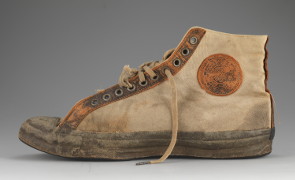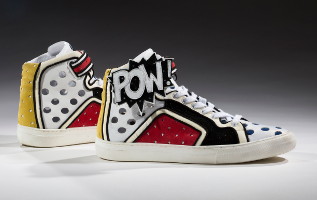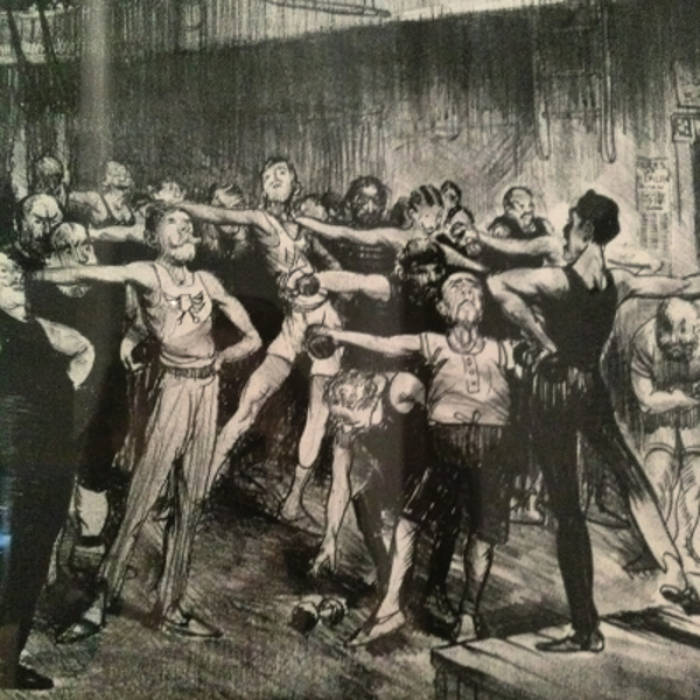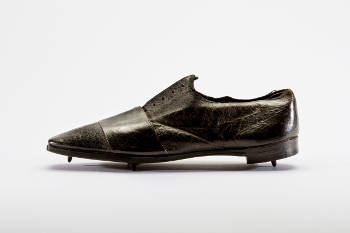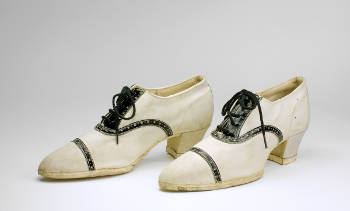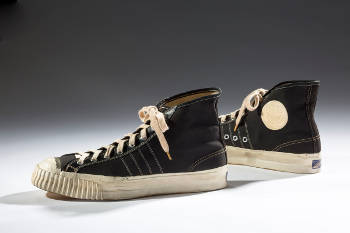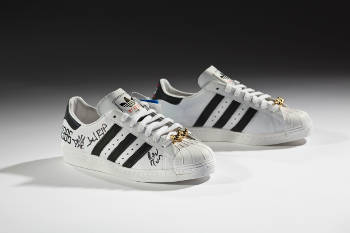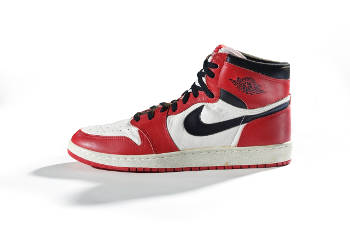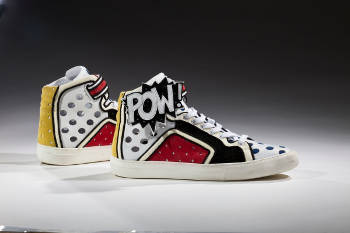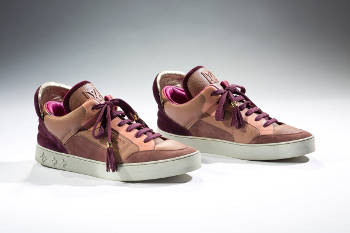CURATOR'S CHOICE SM
Exhibition Reviews
| Home | | Museum
Guide | | International |
| Theater |
Two views of
"The Rise of Sneaker Culture"
at the Brooklyn Museum
Maia Sacca-Schaeffer
Julia Slaff
|
Sneakers are a way of life. As I ride the subway each day my eyes are drawn to the colorful row of feet across from me. Sequins, studs, stripes- each shoe is incredibly different and is a means of self-expression. It hasn't always been this way though. The Brooklyn Museum's "The Rise of Sneaker Culture" seeks to explore this very development and to understand how sneakers have become not only a central part of fashion but also a reflection of historical events, cultural shifts and gender relations. The exhibition includes about 150 pairs of sneakers and is on view July 10 through October 4, 2015, after which it will travel to three other museums. The touring exhibition is organized by the American Federation of Arts (AFA) and the Bata Shoe Museum, seeking to look at how the sneaker moved from its humble beginnings to its present position as urban icon and symbol of status. The collection was curated by Elizabeth Semmelhack, Senior Curator at the Bata Shoe Museum and coordinated in Brookyln by Lisa Small, Curator of Exhibitions at the Brooklyn Museum. The exhibition includes sneakers from manufacturers like Adidas, Converse, Nike, Puma, and Reebok, as well as rare pairs from private collectors and celebrities.
The exhibition is arranged in six sections, each one exploring a different step in the development of sneaker culture. Long glass cases full of shoes stretch out before me and my eyes bounce from one pair to the next. Scattered around the room are TV screens and photos that feature athletes, musicians, and even a look into production at an Adidas factory. This multimedia approach brings to life the story behind each shoe, and interactive tablets give added insight into certain styles or manufacturers. There is even a room were visitors can share their own sneaker story and sketch their favorite shoe. This creates a community feel that incorporates visitors into the exhibit, making our own sneaker experience just as crucial to mapping their evolution. The first room details the "Rubber Revolution" that enabled sneaker production to boom. We begin by journeying back in time to 1830 to chronicle the development of rubber-soled footwear and explore how the vulcanization process was applied to manufacture practical athletic footwear. Technological advancements remain at the core of this narrative in that they allowed sneakers to become available to many more people. I am surprised to see how primitive these sneakers look, much more comparable to leather dress shoes men wear today. Yet as I look closer there are undeniable hints of the sneaker trends to come, especially with an early Converse high top from 1917 with laces all the way up that reminds me of the high tops I frequently wear. This window into the past reveals the ancestors of the shoes on our feet, showing how long these styles have been embedded in our culture.
The exhibition emphasizes the role of women in relation to sneaker culture, and the way their lack of access to sneakers during this early rise stemmed from the perception that athletic activities were "unfeminine." On display is a high heeled sneaker (an ancestor of today's wedge sneaker), that toys with the possibility of being a sneaker by way of its strip of laces and black seams, but retains a stereotypically 'feminine' character with its heel. As I read testimonials from female sneaker designers I learn that the industry remains primarily masculine today, for instance male athletes' shoes are met with a much stronger response than those promoted by female athletes. The exhibition highlights female sneaker designers like Sophia Chang who are working to break down the gender barriers that for a long time have formed the foundation of this industry.
The exhibition progresses from this glimpse into the past towards sneakers' shift from being a purely practical item to a fashion statement. One of the most important developments of this era was Nike releasing the first Air Jordan in the mid-1980s, changing sneakers into something to be collected. These were some of the most sought after shoes around and they revolutionized the sneaker industry. I see an impressive shelf display of Air Jordans that compares the various styles the shoe took on and shows just how many of them were designed. They stand out with their bright colors and innovative styles, and my eyes are drawn to a black pair with a bright red Nike swoosh, opposite a large picture of Michael Jordan sporting his own pair. It is clear how influential these shoes were in changing the image of the athletic shoe, and their design undeniably influences other shoes I see throughout the exhibition. While the exhibit emphasizes sports sneakers and the role of athletes in guiding sneaker culture, the final section highlights design, innovation and "the synergy between sneakers, urban culture, music, and basketball." This last room seeks to look at how sneakers fit into today's global world, many the result of collaborations between designers, celebrities, musicians and athletes to create a single artistic vision. Sneaker design opens up a space for artists to contribute their voice, achieving everything from creating new pop culture trends to enacting social change. These sneakers are objects to be desired, something to flaunt while walking down the street, and as I walk down the last row of cases the shift into the realm of art is undeniable. Immediately I find myself pulled towards Reebok X Alfie "Ball Out's," a re-imagined tennis shoe in which the very material of the shoe is made out of tennis ball-like material. Next I see the Nike Air Max 95's, which evoke the human body with the design of the lacing mirroring the spine and the straps forming ribs. I see Jeremy Scott's "Forum Money" sneakers, covered in dollar bills with Scott's own portrait replacing that of George Washington. There are even shoes by Jimm Lasser with an imprint of Obama on the bottom so that when walking on certain surfaces they leaves an image of the President behind. I am blown away one shoe after the next, their creativity and innovation showing the way sneakers have become a means of fostering artistic expression. My favorite pair comes in the form of the Pierre Hardy "Poworama" sneakers inspired by pop artist Roy Lichtenstein. The shoe takes his iconic "POW" and adds it to a colorful sneaker that sports the polka dots and stipling he is known for.
As I leave the museum I can't help but notice my eyes glued to people's feet. With a now increased awareness I look at the sneaker styles people sport and the way they give me some insight into who they are. Sneakers have evolved into a means of expressing individuality and with their versatility offer something for everyone. The "sneakerfication" of our culture is bound to continue in the coming years, and while we should eagerly look forward to the innovations yet to come, it's nice to take a step back and appreciate the way sneakers provide us with a historical vault that traces the fashion trends, technical innovations, and cultural shifts that have defined who we are today.
Maia Sacca-Schaeffer is a student at Williams College. As of this writing, she is wearing Converse High-Tops.
The Social History of Sneakers
Sneakers are a universal item in anyone’s wardrobe, surpassing age, gender, and social status. However, the story behind sneakers is not as simple as one would think. They have a long history, rivaling jeans, and have become a significant part of our culture. The exhibition “The Rise of Sneaker Culture” evaluates how, as the wall-text notes, “sneakers might appear to be democratic, not all are created equal.” “The Rise of Sneaker Culture” is a touring exhibition created from Toronto’s Bata Shoe Museum, and is organized by the museum and American Federation of the Arts (AFA). Works displayed include sneakers from the Canadian museum, the Kosow Sneaker Museum and the Northampton Museums and Art Gallery. Archives from sneaker companies such as Adidas, Converse, Nike, Puma, and Reebok have shoes on view. Sneaker connoisseurs like hip-hop star Darryl “DMC” McDaniels, “sneaker guru” Bobbito Garcia and “Obsessive Sneaker Disorder” Dee Wells also have their collections shown.
The exhibition is a multimedia marvel which includes videos, photographs, and design drawings giving viewers the whole picture of the social history, design innovations, fashion trends, and endorsements from celebrities that have formed sneaker culture presently. Excerpts from the corollary documentary “Just for Kicks,” tracking sneaker culture from the 1970s to the early 2000s, are likewise screened in the exhibition. The exhibition questions sneaker culture’s advancement in the public eye. Generally, the show inquires why some sneakers become valued more than others. Specifically, “The Rise of Sneaker Culture” ponders how sneakers communicate privilege and inclusion and how these shoes turned from athletic uses to fashion items and icons of masculinity. Most importantly, the exhibition questions how a pair of sneakers can display overtones of social information from just one glance. Answers to these inquires are unveiled through six organized sections. The collection spans the existence of the athletic footwear. Antiques from the origin of sneaker production include a pair of spiked running shoes from 1860 and high-heeled shoes for women from 1925. Likewise, famous sneaker partnerships with artists and celebrities as Pierre Hardy, Damien Hardy, and Kanye West are shown. One of the pivotal items displayed is a pair of Air Jordans I. It is in its own section with a similar appellation, Air Jordans I-XX3, dedicated to the legacy of the shoe collection and its influence in sneaker culture’s evolution. “Innovation,” the exhibition’s first section, accounts for sneaker’s origins from the 1820s to the 1920s. A new vulcanization process, extracting rubber from rubber trees, inspired manufacturers to craft a comfortable athletic wear option. This innovation occurred at the same time as an increasingly more industrialized society craving physical activity to fill its new free time. Included in the section are the oldest running shoes from the 1860s, original Converse All-Stars from 1917 and a pair of rubber-soled canvas-toped Keds from the same period. A version of the latter are still produced today.
The second section, the “Rubber Revolution,” spans 50 years of sneaker development from the 1920s to the 1970s. It evaluates the innovation in sneakers and the consequential rise of consumer culture. Sneakers started being worn by a wider social and age clientele and athletic stars as basketball player Chuck Taylor and tennis pro Jack Purcell commenced showcasing the shoes. Sneakers from the Dominion Rubber Company Fleet Foot, 1925 high-heeled sneakers for women, the Converse Grippers made during the ‘40s and ‘50s, and one of the first leather high-tops, Adidas Allround, from 1960 are shown.
“Body/Sole,” the third section, highlights when high-end
sneakers became symbolic of “conspicuous consumption.” It
evaluates how the sneaker became a new stylish item valuable on the
street and in the gym. “Body/Sole” closes with two important
events in sneaker culture: the launch of the Air Jordan collection in
1985 and the rapper Run-DMC signing with Adidas after the release of
“My Adidas” in 1986.
“Fitness/Fashion,” the fourth section, looks at the union
of basketball, hip-hip, and sneakers from the ‘80s to the present,
when sneakers gained their culturally symbolic value in the eyes of
a mass audience. Sneakers became markers of status and taste in the
framework of “contemporary urban masculinity.” Shoes by
big-name fashion designers such as Jimmy Choo and Lanvin are displayed.
To further illustrate this fad in the rise of sneaker culture, “rare
cult collaborations” such as Adidas x Kanye West Yeezy Boost from
2015 are included.
The fifth section delves into the Air Jordan sensation, which commenced in 1985 following Nike’s signing with basketball superstar Michael Jordan the previous year. Three display cases are filled with Jordan shoes through the ages, specifically "Air Jordans I to XX3," proving their significance in the sneaker industry and the culture as a whole. The final section details sneaker innovation and design, including a display featuring a section of Tinker Hatfield designs and shoes, and many others. The “Innovation” section includes a helpful glossary of words for those outside the phenomenon to understand. The exhibition is on view at the Brooklyn Museum from July 10 to October 4, 2015. [Julia Slaff] |
